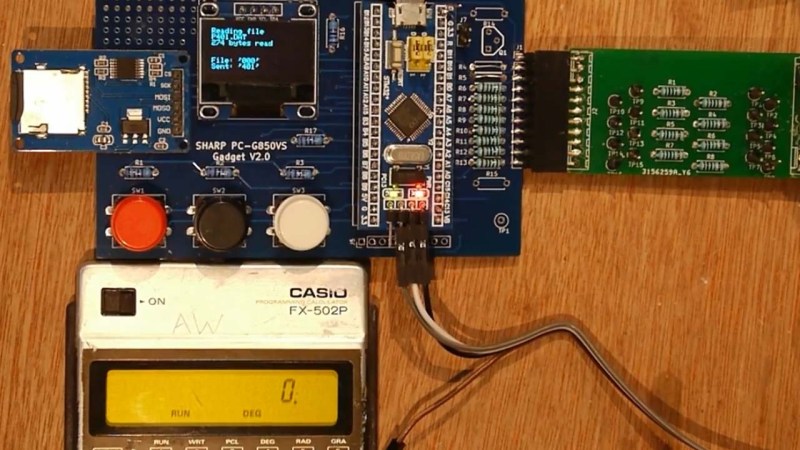When is a pocket calculator more than just a calculator? [Andrew Menadue] has been pushing the limits of his 1970s Casio FX-502P by adding all sorts of modern functionality via the calculator’s expansion port.
Several older Casio calculators included an expansion port for connecting cassette tape storage and printing functionality. Data on the FX-502P could be saved on cassette tape using the well-known Kansas City standard, however this signal was produced by Casio’s FA-1 calculator cradle, not the FX-502P itself. To interact with the calculator itself would require an understanding of whatever protocol Casio designed for this particular model.
It turns out that the protocol is a little quirky compared to its contemporaries, with variable length data packets and inverted data logic, (zero volts is ‘1’ and three volts is ‘0’). Once the protocol was untangled, it was ‘simply’ a matter of connecting the calculator to the GPIO interface on the STM32, and using some software wizardry to start shooting data packets back and forth.
This hack can be used to send and receive data from an SD card (via a RAM buffer), however it’s the other expansion capabilities that really make us wonder. [Andrew] has demonstrated how easy it is to add a real-time clock or thermal printer. Using the I2C capabilities of the STM32, it’s likely that all sorts of gadgets and sensors could be coupled with this vintage calculator, and many others like it.
You can find even more details about this hack over here, including some follow up videos to the original hack. No stranger to vintage calculators, we last featured [Andrew] after he retrofitted a modern LCD display to an old Casio. It’s charming to see how these calculators are far from obsolete.















My guess is that this should also work with the FX-501P and the FX-601P and FX-602P, all of which could use the FA-1 cassette interface, although the latter pair have a different (enhanced) instruction set
.
Casio fun fact (verified by the oracle of all human knowledge ;¬) Wikipedia) The FX-501P was used on the 1981 song Pocket Calculator by electronic music group Kraftwerk.
Yes, this will work with the FX501P. As it stands, thoiugh it won’t work with the FX602P as that uses a slightly different protocol to the FX502P, even though both work with the FA-1, surprisingly.I intend to update the code though…
Absolutely outstanding work, I’d love to get the sketches!
The repository for this is here:
https://github.com/blackjetrock/fx502p-sd
It has the code and the PCB files.
“It’s charming to see how these calculators are far from obsolete.”
I respectfully beg to disagree. This is an impressive “retrofitting” work clearly born out of passion and desire for knowledge, but it has very little (if close to none) appliance in real life world. These calculators *are* obsolete in what regards interoperability and functionality in scope of the modern technology. One could argue (and I would agree) that since they weren’t designed in an age where “programmed obsolescence” dictated technology development they are still working and operable. But this is isn’t enough to not declare them obsolete.
On the other hand, another similar reasoning would be that since the science behind it is still the same one could theoretically continue to use such devices without issues (aka, “math is still math”). And while this is true, somehow we don’t use abacus anymore nor we “print” calculations on wax-covered clay tablets: technically they both still “work” but indeed they are both very much obsolete and there is no practical need to attach a “digital counter” or an “e-ink display” to neither of those.
You have to be careful when you define “obsolete”. My mechanical watch is “obsolete” in the sense that there are an infinite number of phones and other gadgets around that “do the same job more accurately”/ However they wont still be working when I can’t charge them, nor if I leave them at home.
Similarly I can grab my old FX-602P and program in a few lines to perform a simple task without having to fire up the laptop, and code the same thing in an IDE, or ask Aunty Google for the answer.
I guess an item becomes obsolete when there are no longer any people willing to use it, or, in this modern world, it becomes obsolete when the provider no longer allows it to be used. The good thing about an old calculator is that Casio can’t switch it off because they are no longer willing to support their proprietary calculator app as it is no longer financially viable for them to do so.
“Obsolete”, historically has been a matter of perspective. Going forward however, it may be a matter of manufacturers choice. We do indeed live in interesting times.